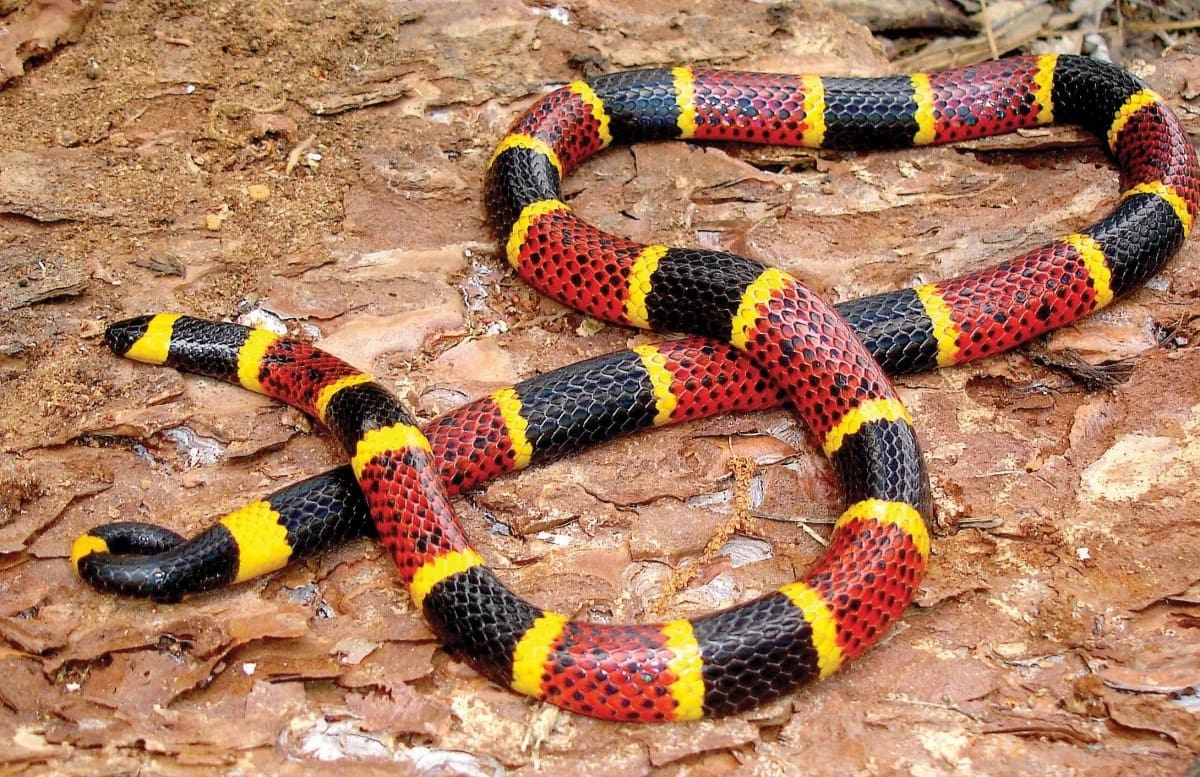
Coral snakes are fascinating creatures that capture the imagination with their vibrant colors and secretive nature. These venomous serpents, belonging to the Elapidae family, are found in various parts of the world, including the Americas and parts of Asia. While they may not be as well-known as some other snake species, coral snakes possess unique characteristics that make them truly astonishing.
In this article, we will explore 19 remarkable facts about coral snakes, shedding light on their appearance, behavior, venom, and their importance within their ecosystems. So, prepare to delve into the intriguing world of coral snakes and discover some surprising information about these beautiful and elusive reptiles.
Key Takeaways:
- Coral Snakes are small, colorful, and non-aggressive, but their venom is highly toxic. They play a vital role in their ecosystems and need our protection to survive.
- Coral Snakes are fascinating nocturnal hunters with poor eyesight. Their unique traits make them both dangerous and captivating, highlighting the importance of conservation efforts.
The Coral Snake is Highly Venomous
The Coral Snake is known for its potent venom. It possesses one of the most toxic snake venoms in the world, making it a dangerous creature to encounter in the wild.
Coral Snakes Have a Distinctive Coloration
These snakes are easily recognizable by their striking color pattern. They have vibrant rings of red, yellow, and black along their bodies, providing a warning to potential predators.
The Coral Snake is Part of the Elapidae Family
The Coral Snake belongs to the Elapidae family, which includes other venomous snakes such as cobras, mambas, and sea snakes. This family is known for its potent neurotoxic venom.
They Have a Small Size
Coral Snakes are relatively small, typically measuring between 20 and 30 inches in length. Despite their small size, their venom can be deadly if not treated promptly.
Coral Snakes are Non-Aggressive
Contrary to popular belief, Coral Snakes are not aggressive and will often try to avoid confrontations. They would rather retreat and hide rather than engage in a conflict.
Their Bite Can Be Painless
Due to their small fangs, a bite from a Coral Snake may initially be painless. However, this does not diminish the seriousness of the situation, as the venom can cause significant harm.
Coral Snakes are Found in North and South America
These snakes are native to North and South America, with different species inhabiting various regions. They can be found in wooded areas, swamps, and even in some urban environments.
The Coral Snake has a Powerful Neurotoxic Venom
The venom of the Coral Snake attacks the nervous system, causing paralysis and potentially leading to respiratory failure if left untreated. Immediate medical attention is crucial in the case of a bite.
They are Efficient Predators
Coral Snakes predominantly feed on smaller reptiles, including other snakes and lizards. They use their venom to immobilize their prey before swallowing them whole.
There are Several Species of Coral Snakes
There are various species of Coral Snakes, including the Eastern Coral Snake, Western Coral Snake, and Texas Coral Snake. Each species has its own unique characteristics and habitat preferences.
Coral Snakes are Secretive Nocturnal Creatures
These snakes are primarily active during the night and prefer to remain hidden during the day. They are excellent burrowers and can often be found hiding in leaf litter or underground.
Coral Snakes Have a Slow Metabolism
Due to their slow metabolism, Coral Snakes have a lower energy requirement compared to other snake species. This allows them to survive without frequent meals.
They Lay Eggs
Coral Snakes are oviparous, meaning they lay eggs rather than giving live birth. The female will lay a clutch of eggs, which will hatch after an incubation period of several weeks.
They Have a Long Lifespan
Coral Snakes have a relatively long lifespan compared to other snake species. They can live for up to 10 years or more in the wild, given the right conditions.
Coral Snakes Have Poor Eyesight
These snakes rely more on their keen sense of smell and their ability to detect vibrations in the ground to locate prey. Their poor eyesight does not hinder their hunting abilities.
The Coral Snake’s Bite Can Be Deadly
While encounters with humans are rare, a bite from a Coral Snake should be treated as a medical emergency. Prompt administration of antivenom is crucial in preventing serious complications.
They Have Predators of Their Own
Despite their potent venom, Coral Snakes also have natural predators. Animals such as birds, mongoose, and certain snake species are known to feed on them.
Coral Snakes Are Not Aggressive Towards Humans
These snakes will typically only bite if they feel threatened or provoked. If given the opportunity to escape, they will prefer flight over confrontation.
Conservation Efforts Are Essential
As with many species, the habitats of Coral Snakes are under threat due to human activities and habitat loss. Conservation efforts are necessary to ensure their survival in the wild.
In conclusion, these 19 astonishing facts about Coral Snakes provide a glimpse into the captivating world of these venomous reptiles. Their vibrant colors, potent venom, and secretive nature make them fascinating creatures to study and admire from a safe distance.
Conclusion
In conclusion, coral snakes are truly fascinating creatures that possess a unique set of characteristics and behaviors. From their vibrant colors and distinct patterning to their potent venom and reclusive nature, these snakes continue to intrigue scientists and nature enthusiasts alike. Despite their venomous nature, coral snakes are not aggressive and will generally only bite when threatened or provoked. It is important to remember that they are not commonly encountered and pose little threat to humans as long as appropriate precautions are taken. With their delicate beauty and important ecological role, coral snakes serve as a reminder of the incredible diversity found in the animal kingdom. By continuing to learn about and appreciate these remarkable creatures, we can contribute to their conservation and preservation for future generations to enjoy.
FAQs
Q: Are coral snakes dangerous?
A: Yes, coral snakes are venomous and possess a powerful neurotoxin. However, they are generally not aggressive and will only bite as a means of self-defense.
Q: Can coral snakes be kept as pets?
A: Keeping coral snakes as pets is highly discouraged due to their venomous nature and specialized care requirements. It is best to admire these snakes in their natural habitat or visit reputable reptile exhibits.
Q: What should I do if I encounter a coral snake?
A: If you come across a coral snake, it is important to leave it undisturbed and do not attempt to handle or capture it. Keep a safe distance and appreciate it from afar.
Q: Are all coral snakes deadly?
A: While all coral snakes are venomous, not all species have a venom that is potent enough to cause significant harm to humans. The severity of the bite depends on factors such as the species, size of the snake, and the amount of venom injected.
Q: How can I identify a coral snake?
A: Coral snakes can be identified by their distinctive red, yellow, and black bands that encircle their body. A common rhyme to help with identification is “Red on yellow, kill a fellow; red on black, venom lack” referring to the pattern on the snake’s body.
Q: Do coral snakes serve any ecological purpose?
A: Yes, coral snakes play an important role in the ecosystem as predators, helping to control populations of small reptiles and amphibians. They also serve as indicators of ecosystem health, as their presence or absence can reflect the overall well-being of their habitat.
Was this page helpful?
Our commitment to delivering trustworthy and engaging content is at the heart of what we do. Each fact on our site is contributed by real users like you, bringing a wealth of diverse insights and information. To ensure the highest standards of accuracy and reliability, our dedicated editors meticulously review each submission. This process guarantees that the facts we share are not only fascinating but also credible. Trust in our commitment to quality and authenticity as you explore and learn with us.


